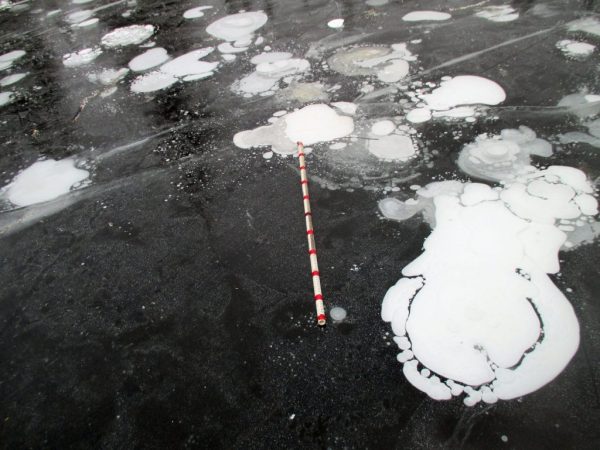
One of the many greenhouse gases contributing to global warming is methane. Methane is emitted in a lot of ways, including from lakes across Alaska. However, studies on how much methane flows up from those lakes into the atmosphere haven’t always been very accurate.
New research from the University of Alaska Fairbanks using radar instruments positioned on satellites has led to a breakthrough in lake methane emission research. That research could help climate scientists better see how Alaska’s lakes contribute to the world’s methane emissions
As permafrost under lakes begins to break down, it releases carbon, which is broken down by tiny microorganisms, which in turn, release methane.
“Sometimes you’ll sit on the edge of the lake and you can see a little pop,” said Melanie Engram, a researcher with the University of Alaska Fairbanks Water and Environmental Research Center. “And you might think ‘oh hey, it’s a fish.’ But it could also be a little methane bubble that’s coming out.”
Since methane is an odorless, colorless gas, it can be difficult to monitor how much is released by lakes. But not when they’re frozen.
“The ice forms around the bubbles; more bubbles are released and [ice] forms around the bubbles,” Engram said. “And the ice creates a time-lapse freeze frame, pardon the pun. It’s a freeze-frame historical record of the methane bubbling.”
To study these methane bubbles, Engram and other researchers use small bubble traps to make micro-measurements of methane and then scale them up to the full area. However, she says, those aren’t super accurate.
“The bubbling is very spatially erratic and it’s sporadic; you’ll see a big stream of bubbles and then it will shut off for a while,” Engram said.

Now, UAF researchers have begun to use what’s called a synthetic aperture radar, or SAR, to better map methane being released from lakes. Basically, a satellite sends a pulse down to a lake. A portion of that pulse bounces back to the satellite in what’s called a backscatter. Backscatters range in luminosity from kind of dim to very bright.
“The radar return was brighter in lakes that had more methane, and it was dimmer or lower in lakes that had less methane,” Engram said.
Engram and other researchers used SAR to map methane emissions from 48 lakes across five regions of Alaska, including the northern Seward Peninsula near Kotzebue, lakes near Atqasuk — south of Utqiagvik — and the Fairbanks area.
Of course, researchers still had to go out to the lakes that SAR was mapping to make sure it actually worked. To Engram’s delight, it did.
“It was really exciting for me to go out to a lake that was really bright in SAR, and to snowmachine out to it and dig down in the snow, and there were just bubbles everywhere in the ice,” Engram said. “I was excited. I said, ‘This is working! Yay, it works!’”
Engram says the success of using SAR to map out methane emissions in Arctic lakes means the system can monitor thousands of lakes across the state. And that’s not just exciting from a research perspective. Engram says that there isn’t a lot of global data on methane release from lakes, and use of the SAR can help create a baseline to track in the future. That will be useful to climate scientists tracking changes in the atmosphere.
“People measure methane in the atmosphere and they say how much comes from anthropogenic sources like oil fields and automobiles and agriculture and dairy cows,” Engram said. “They try to divide it up so we can see the different sources. And this will help [balance] the global methane budget.”
Studies show that methane is about 30 times stronger than carbon dioxide as a heat-trapping gas. And while methane is naturally emitted from these lakes, Engram says the amount is drastically dwarfed by the amount produced from those anthropogenic sources.
Engram’s research using SAR to track methane emissions in Arctic lakes was the subject of a UAF research paper that was published this month in the scientific journal Nature Climate Change.
Wesley Early is a reporter with Alaska Public Media, covering municipal politics and Anchorage life.




